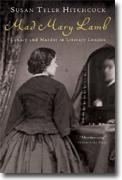Mad Mary Lamb
Susan Tyler Hitchcock
book reviews:
· general fiction
· chick lit/romance
· sci-fi/fantasy
· graphic novels
· nonfiction
· audio books
· author interviews
· children's books @
curledupkids.com
· DVD reviews @
curledupdvd.com
newsletter
win books
buy online
links
home
for authors
& publishers
for reviewers

 |
Mad Mary Lamb: Lunacy and Murder in Literary London Susan Tyler Hitchcock W.W. Norton Paperback 336 pages February 2006 |
|
When Mary Lamb thrust a knife into her mother’s chest in 1796, the crime became the talk of the city, her name on every tongue. At a terrible cost, Mary Lamb broke free of the drudgery that consumed her days; she would eventually be touted for her wit and intelligence as a co-author of immensely popular children’s books.
Causing no further disturbance to anyone for the rest of her life, Mary never again committed an act of violence and was released after a year into the care of her writer brother, Charles Lamb. Although she had an apartment of her own, Charles and Mary Lamb devised a manner of living (what Charles called “double-singleness”) and the woman accepted into her brother’s literary circle. Appreciated for her sharp intelligence and intellectual curiosity, Mary co-authored three books with her brother: Tales from Shakespeare (1807), Mrs. Leicester’s School (1809) and Poetry for Children (1809). Mary was content to remain on the fringes of literary society, living out her days pen in hand. Most women were hidden behind society’s restraints, great literary achievements solely the purview of the male gender. Charles moved in and out of his own creative forays while Mary nurtured the seeds of her own work with her unique ability to step inside other’s identities: “It was her deep and sympathetic feeling, coupled with her intellect, that brought her admiration from men of such high standards as Coleridge.” Mary Lamb transgressed just enough to participate in a lively literary society at the side of her prolific brother, an accomplished essayist, far more than the dreary spinsterhood that would have been her fate had she not committed the crime. Her creativity would have been forever stifled by a spinster’s role in society that relegated her to little more than a domestic servant, albeit to family, but the infamous crime of passion afforded Mary an extraordinary opportunity as a female writer in a man’s world. With extraordinary detail and copious notes, bibliography and index, Hitchcock’s Mad Mary Lamb is brought to life on these pages - her crime, tentative reach toward life, and the fulfilling world of writing afforded by a violent transgression against society’s most basic tenet. Originally published on Curled Up With A Good Book at www.curledup.com. © Luan Gaines, 2006 |
|
|
|
 Click here to learn more about this month's sponsor! |
|
| fiction · sf/f · comic books · nonfiction · audio newsletter · free book contest · buy books online review index · links · · authors & publishers reviewers |
|
| site by ELBO Computing Resources, Inc. | |
 Caught in that terrible moment, Mary was only aware of the rage that overcame her and left her mother, a crippled and querulous old woman, dead at her daughter’s hand. Lamb was incarcerated in Fisher House, a private, quasi-affordable madhouse in Islington, England, where she underwent the usual brutal treatments dictated by science at the time, similar to those King George III was subjected to ten years before: “Lunacy replaced moral defect as an explanation for violence in extraordinary circumstances.”
Caught in that terrible moment, Mary was only aware of the rage that overcame her and left her mother, a crippled and querulous old woman, dead at her daughter’s hand. Lamb was incarcerated in Fisher House, a private, quasi-affordable madhouse in Islington, England, where she underwent the usual brutal treatments dictated by science at the time, similar to those King George III was subjected to ten years before: “Lunacy replaced moral defect as an explanation for violence in extraordinary circumstances.”